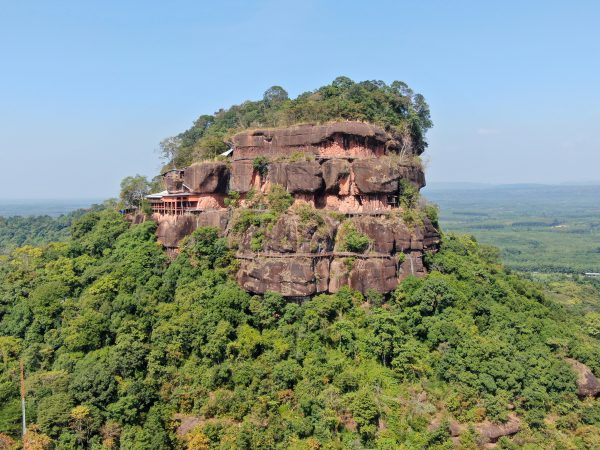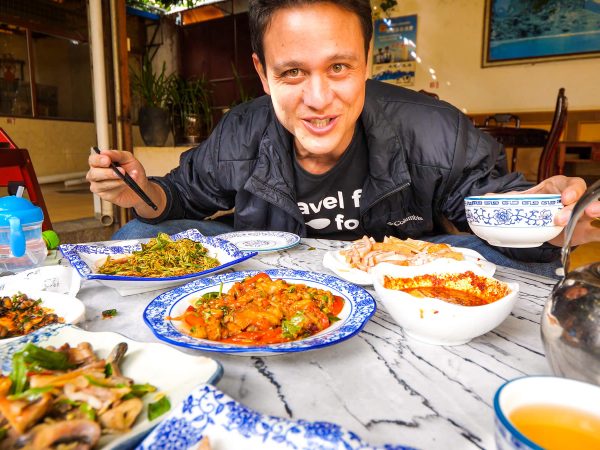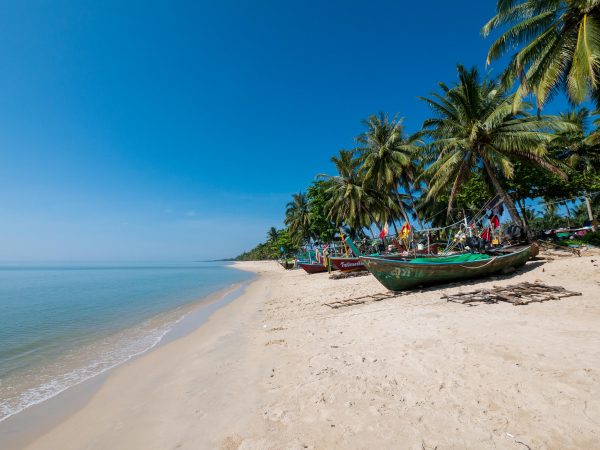

Chiang Rai, located in the northern tip of Thailand, is one of my favorite regions of the country.
The green rolling hills and mountains, the thick jungle, and the peacefulness of the area, is what I love most about visiting.
While filming the Thai food documentary, we went to Chiang Rai province to film a section of the show about Thai roasted and burnt foods (and that’s why we learned how to cook in bamboo over fire – keep reading below).

Akha Tribe in Thailand
The Akha people are a tribe originally from southern China, who migrated to southeast Asia, and now live in mainly Thailand, Myanmar, Laos, and some still in the Yunnan province of China.
Akha’s are known as a hill tribe, a group of people who live in the heavily forested hills and mountains.
There are an estimated 80,000 Akha people living in Thailand, most of them in and around Chiang Rai and Chiang Mai.

Akha Hill House
In Chiang Rai town, there are plenty of companies that offer tours of Akha villages, including accommodation, trekking, and cultural learning trips.
One of the more established Akha tours in Chiang Rai, is the Akha Hill House, which can arranged from the Akha River House* in Chiang Rai town.
Our group, Ying and I, along with the film crew, arranged a tour of an Akha village, where our main motive was to cook in bamboo.

The Akha Hill House, was about a 1 hour drive from Chiang Rai, and we all jumped into the back of a pick-up for the ride.
Along the ride, there were beautiful views of the jungle and rice fields, and the views kept getting better as we climbed higher into the hills.

We arrived at Akha Hill, which is a very small, and very pleasant village, located at the top of a hill, surrounded by lush jungle.

Our room…
Though there are a number of different room choices, the rooms at Akha Hill House are all pretty basic.
Ying and I had a fan room, which since it was cool, we didn’t really need an AC anyways. The room was made from wood and bamboo, and it was adequate.
Don’t expect anything fancy, but I thought it was alright – our bathroom could have used some cleaning.
It was similar to the rooms we stayed in on our trip to Kanchanaburi.

Akha herbal sauna
Something I probably wouldn’t have done on my own, but they wanted to film it, was a session in the traditional Akha style herbal sauna.
P’Aper, the owner of Akha Hill House, told me the Akha herbal sauna is usually for women after giving birth, but it’s alright for anyone to use it too.
While I was in the sauna, a rainstorm came, but luckily it only lasted for a few minutes.

Just before dinner, there were some beautiful views of the mountains and the sunset, right after the rain cleared.

Akha dinner
If you stay at the Akha Hill House, you don’t really have much choice for dinner, other than eating at the lodge.
For dinner we had a thin vegetable soup, stir fried vegetables with chicken, and a nam prik (Thai chili sauce) made from tomatoes and peanuts, served with boiled vegetables.
The boiled vegetables and chili sauce started to remind me of Naga food, a region that actually isn’t too far from this area of Northern Thailand.
Overall, I thought the meal was a little toned down touristy, and could have been better.

The next morning…
One thing I love to do, especially in the countryside, is wake up early in the morning to enjoy the sunrise, and just the beauty of the beginning of a new day.
The view from our room balcony was wonderful, and in the morning there was lots of fog coating the tips of the hills.
It was just like driving to Doi Chaang (coming soon), but this time it was nice to be admiring the fog, instead of driving in it!

Rambutans
The Akha village was filled with rambutan trees, and unlike the red rambutans I’m used to seeing in Bangkok, these were yellow in color, and fully ripe.
Picked right off the tree, they were incredibly sweet and juicy – few things are better than fresh fruit right off the tree.

Jungle trek
After eating a quick breakfast, we got ready for a quick jungle trek, where we’d learn how to go fishing and cook in bamboo, the traditional Akha style.

We didn’t actually really trek too far, we mostly took a drive down the road, loaded up all our gear, and went walking for about 30 minutes or so, until we arrived at a small clearing in the jungle where they often take tour groups.
Along the trail, we crossed a few small streams.

While trekking, the scenes of the jungle were fantastic.

While hiking, our guides showed us many fascinating things in the jungle.
Pictured above is P’Aper, the owner of Akha Hill House and an Akha guide, whistling with a leaf.

Dam fishing
Once we arrived to the little tour base in the jungle, we first got into the stream, and they showed us how to fish the traditional Akha way.
The stream was about 2 – 3 meters across, and not very deep, more of a rocky stream.

There were about 5 Akha guys with us, who were along to help.
They immediately started piling rocks into the center of the stream, channelling the flowing water to one side, and attempting to dry out the other side.
They kept piling on rocks, and then added mud from the bank over the rocks to make sure no water was coming out.
So one side of the stream all the water was channeling through, and on the other side, the water was sitting still.

Working fast (before the makeshift dam would collapse), we started scooping out the water from the stagnant pool, using our hands and bamboo troughs.
In the pools of water, created by the dam, were fish that had gotten trapped.
We didn’t catch anything too big, but we did get some small fish, some crabs, and small shrimp (not quite like the Ayutthaya shrimp, but they were freshwater little shrimp).

The Akha style dam fishing was probably the most interesting part of the tour for me, because it was my first time to see fishing done this way, and it was also pretty cool that we caught some fish… which we ate later on.

As we were fishing, a few tour guide helpers, got busy chopping down green poles of bamboo, and carving out chopsticks and cups.
They were pretty slick, and I’m sure they had cut and carved bamboo cups and chopsticks thousands of times, both for themselves while growing up, and for every single tour from the Akha Hill House.

Bamboo
I’ve often though that bamboo is one of the world’s most amazing and versatile plants (or it’s actually a species of grass).
Around southeast Asia, both homes and furniture are often constructed of bamboo.
Then there are bamboo mats, utensils, tools, and perhaps my favorite use of bamboo, for construction scaffolding (especially common in China and Hong Kong).
The first place I saw bamboo being used as a pot for cooking was in Nagaland, but I was excited to see the way they cooked in the Akha culture as well.

Cooking in bamboo
The main reason we took an Akha hill tribe tour while we were in Chiang Rai, was to focus on their grilling and roasting cooking methods.
They cut a few long green bamboo poles, and began to select the long segments of the bamboo, chopping off the bottom just after the bamboo segment, to create a long slender cup.

Along with the small fish we had caught (which wasn’t nearly enough for us all to eat), they brought chicken, rice, eggs, and vegetables (and instant noodles) to cook in the bamboo.
First they stuffed all the ingredients into the bamboo, along with a bit of water.

Unlike grilling, where you want a nice bed of hot coals to evenly cook something, when cooking in bamboo over fire, you need a nice flame.
The fire was fueled mostly by dry pieces of bamboo, and above the fire was a little upright stand to lean the bamboo cooking pots against.

For covers, the bamboo was stuffed with leaves.

Fish cooked in bamboo
The first dish I tried was the fish and little shrimp cooked in bamboo.
After it was finished cooking, they dumped it into a banana leaf bowl.

Chicken cooked in bamboo
They carried a pre-cut chicken along with us from the village, and then just mixed it with onions and chives, and stuffed it into the bamboo cup along with some water before putting it over the fire.
A little disappointing…
One thing I wasn’t too impressed by, is that they just took all the ingredients (all of the dishes), and doused them in Knorr seasoning mix for flavor.
It wasn’t exactly what I was expecting, and though it’s a sure way of making anything tasty (and I understand that being in the jungle camping there’s not a lot of options – so I’m not being picky here), I would have just preferred some simple salt and pepper – or just the traditional Akha way of seasoning.

Jungle tea
After fishing, cooking in bamboo poles, and eating, I then got a chance to try out my fresh bamboo cup, by drinking a cup of hot wild jungle tea.

The local jungle tea came from a bush that was quite a bit bigger than a normal tea plant, but it tasted very similar (I probably couldn’t tell the difference) to regular green tea.

Some things to consider…
When you’re in Chiang Rai, and if you’re interested to do something like this, there are plenty of tour companies that offer tours to Akha villages.
We went to the Akha Hill House*.
I’d say it was a good opportunity to be surrounded by nature and to learn more about Akha culture. The accommodation was alright, but very basic, so don’t go expecting anything too fancy. Also, the food was alright, but a little touristy.
As for trekking, we went on a tour, which included a very small trek, and then lunch in the jungle.
I think they often do group treks and tours, so being with a full group of random people might take away from the overall fun of being in the jungle (but depends on what you’re looking for).
Conclusion
Chiang Rai is one of my favorite areas of Thailand for its natural beauty and peacefulness.
When I was in Chiang Rai, we took a tour to the Akha Hill House village, to mostly learn about their traditional style of cooking in green bamboo.
Probably my favorite part of our trip was leaning how to go fishing, by making a dam in the stream, to trap the fish in small pools of water.
It was also a lot of fun learning how to cook the traditional Akha tribe way, using green bamboo poles as pots.
Overall, though it was a little touristy, I thought it was fun, and mostly what I loved was being in the jungle, the peacefulness, and leaning about Akha culture.
(NOTE: I am the host of a Thai food TV documentary, where we are traveling around Thailand eating unique and delicious foods. I am attempting to take photos and blog about all the things we do and eat. You can check out the full series by clicking here.)
Get exclusive updates
Enter your email and I'll send you the best travel food content.



